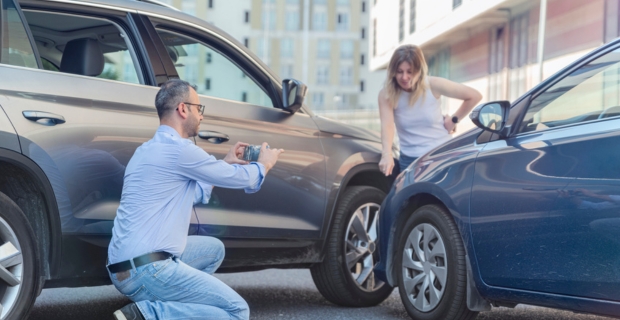Date Published: 2024/06/10
Read Time: mins
Accidents happen: What to do after a car collision

The moments following a car collision can be stressful and disorienting, leaving you feeling overwhelmed and unsure of what to do next. Having a clear plan of action for what to do after a collision can help you manage the situation with clarity and confidence.
In this article, we'll walk you through the essential steps to follow after a car collision, from ensuring everyone's safety to starting the claims process.
On-road collisions: What to do after an accident
1. Check for injuries and call 911 if needed. Safety is always the top priority. Check yourself and your passengers for injuries. Call 911 immediately if anyone in your vehicle or the other vehicles involved needs medical attention. Do not attempt to move anyone who is injured. Wait for emergency services to arrive at the scene and follow any instructions provided by the 911 operator.
2. Move to a safe location. If your vehicle is drivable and nobody inside is injured, carefully move it to the side of the road if it is safe. Turn off your engine, turn on your hazard lights, and if you have them, set up traffic cones or flags to warn other drivers. If your vehicle cannot be moved, get yourself and any passengers to a safe location such as the sidewalk or the side of the road. Avoid authorizing any towing services until you have spoken with your insurance provider.
3. Determine if police should be called to the scene. You must report an on-road collision to the police immediately if any of the following apply:
- Somebody is injured.
- A pedestrian or cyclist was involved in the collision.
- Combined vehicle damage meets or exceeds the provincial threshold
- In Ontario and Nova Scotia the regional damage threshold is $2,000, so you would need to contact police if the estimated damage to all vehicles involved totals $2,000 or more.
- In Alberta, the threshold was recently increased to $5,000.
- Research your province’s guidelines to understand when the damage is considered major enough to require a police report.
- Criminal Code violations such as impaired driving, a stolen vehicle, or assault are involved.
- One of the drivers is uninsured, unlicensed, or has a suspended license.
- One of the drivers does not cooperate or leaves the scene.
- The collision involves a government vehicle.
- The collision caused damage to private or municipal property.
If you’re having trouble evaluating the damage or are unsure if any of the outlined criteria apply, contact the local police department for instructions.
4. Record details of the collision. Once in a safe location, document the scene by recording:
- Time, date, and location
- Your speed at the time of the collision
- Weather and road conditions
- Photos of the collision scene and vehicles involved
- Contact information for any witnesses of the collision
5. Exchange information. Exchange the following information with all drivers involved:
- Full name
- Contact information
- Driver's license number
- License plate number
- Insurance company and policy number
- Vehicle type, colour, and model
Avoid discussing the facts of the collision with the other parties involved. Do not admit fault or assign blame at the scene. Never sign any documents regarding fault or agreeing to cover damages. Fault will be determined by your insurance company based on provincial guidelines.
6. Contact your insurer. Contact your insurance company as soon as possible to notify them about the collision and discuss next steps. Your insurer will help you understand what actions to take, what they will need to start processing the claim, and what to expect during the claims process. Prompt communication can help expedite the claims process and ensure a timely resolution.
7. Seek medical attention if you suspect you have accident-related injuries. Once the shock of the collision wears off, you may start to notice signs of injury that were not immediately apparent. If this is the case, seek medical attention promptly. Keep your insurer informed of any injuries that may present themselves in the days following the collision. Maintain a record of any accident-related doctor appointments, treatments, and expenses.
8. Visit a Collision Reporting Centre (CRC) if applicable in your area. Depending on where you live, you may need to take your vehicle to a Collision Reporting Centre (CRC) to file a report.
- In Ontario, you must bring your vehicle to a CRC within 24 hours of the collision, along with your driver’s licence, vehicle ownership, and insurance information.
- In Alberta, if the repair cost meets the regional threshold of $5,000, you will need to bring your vehicle to a CRC to get a damage sticker before an auto body shop can begin repairs.
- If your vehicle is not drivable, you will need to get a tow from the collision scene to transport you and your vehicle to the closest CRC.
- If you’re unsure if your region has a CRC, contact your local non-emergency police line to find out.
While no one plans on being involved in a car collision, being prepared and knowing what steps to take can help you navigate the aftermath with confidence. Remember to stay calm, prioritize safety, and maintain close communication with your insurer.
At Orbit Insurance Services, we understand the importance of having the right coverage to protect you and your vehicle in a collision. Our team of experienced insurance brokers is here to help you find the right coverage for your needs and budget. If you're shopping for auto insurance, call an Orbit insurance broker for a free personalized quote.
If you're a current Orbit customer and have questions about your current auto insurance policy or want to discuss your coverage options, contact your broker today.